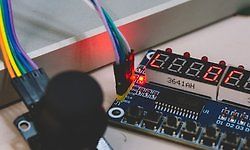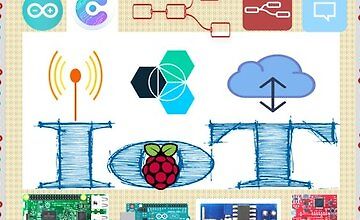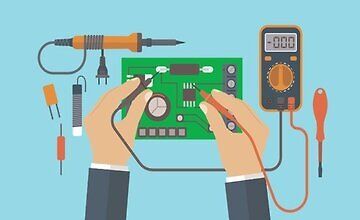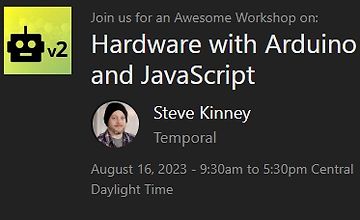-
Урок 1.
00:06:43
What is this course about?
-
Урок 2.
00:18:03
Parts you will need
-
Урок 3.
00:09:53
Tools you will need
-
Урок 4.
00:03:40
How to get the most out of this course
-
Урок 5.
00:03:04
Update 2022 brief
-
Урок 6.
00:00:41
Introduction to this section
-
Урок 7.
00:13:12
The Arduino Uno over the years
-
Урок 8.
00:11:01
Getting to know the Arduino Uno: Atmega328P, USB, Shields
-
Урок 9.
00:10:19
Getting to know the Arduino Uno: Pins, power, clock
-
Урок 10.
00:13:15
Using the digital output pins
-
Урок 11.
00:10:19
Using the digital input pins
-
Урок 12.
00:08:16
Using the analog output pins
-
Урок 13.
00:08:03
Using the analog input pins
-
Урок 14.
00:00:50
Introduction to this section
-
Урок 15.
00:07:44
Serial (UART) communications
-
Урок 16.
00:08:25
I²C (TWI) communications
-
Урок 17.
00:07:35
SPI communications
-
Урок 18.
00:01:02
Introduction to this section
-
Урок 19.
00:12:47
Arduinos past and present
-
Урок 20.
00:01:24
Classic Arduinos
-
Урок 21.
00:05:11
Meet some members of the Arduino family
-
Урок 22.
00:05:15
Introducing the Arduino Mega 2560
-
Урок 23.
00:06:54
Introducing the Arduino Due
-
Урок 24.
00:05:18
Introducing the Arduino Zero
-
Урок 25.
00:03:40
Introducing the Arduino 101
-
Урок 26.
00:04:57
Introducing the Arduino Pro Mini
-
Урок 27.
00:10:44
Introducing Arduino-compatible boards
-
Урок 28.
00:10:17
Modern Arduinos
-
Урок 29.
00:06:11
Arduino MKR
-
Урок 30.
00:05:26
Arduino Nano
-
Урок 31.
00:02:06
Kits
-
Урок 32.
00:05:22
Arduino Student Kit
-
Урок 33.
00:08:16
Arduino Explore IoT Kit
-
Урок 34.
00:05:20
Seeed Studio Arduino Sensor kit
-
Урок 35.
00:08:42
DFRobot Beginner Kit for Arduino
-
Урок 36.
00:00:33
Introduction to this section
-
Урок 37.
00:13:57
Using the breadboard
-
Урок 38.
00:07:11
Using jumper wires
-
Урок 39.
00:08:02
The absolutely essential tools
-
Урок 40.
00:04:02
Powering your Arduino with power supplies
-
Урок 41.
00:07:27
Using the multimeter to measure voltage
-
Урок 42.
00:05:29
Using the multimeter to measure current
-
Урок 43.
00:06:36
The multimeter - Resistance and continuity
-
Урок 44.
00:23:40
The Arduino Student Kit multimeter
-
Урок 45.
00:11:25
Introduction to soldering - the soldering iron
-
Урок 46.
00:05:17
Soldering - preparation and using holders
-
Урок 47.
00:02:23
Soldering - using wire cutters and fume extractor
-
Урок 48.
00:03:08
Soldering - Simple maintenance tips for your solder iron
-
Урок 49.
00:13:48
A demonstration of soldering a header onto a breakout board
-
Урок 50.
00:15:22
An introduction to protoboards
-
Урок 51.
00:00:47
Introduction to this section
-
Урок 52.
00:05:25
Arduino IDE 1.8
-
Урок 53.
00:10:25
Arduino IDE 2.0
-
Урок 54.
00:08:01
An introduction to the Arduino IDE
-
Урок 55.
00:07:46
Getting and installing the Arduino IDE
-
Урок 56.
00:18:14
The Arduino IDE - Understanding the Preferences pane
-
Урок 57.
00:12:50
The Arduino IDE - Understanding the Menu items
-
Урок 58.
00:09:38
How to upload a sketch to your Arduino
-
Урок 59.
00:09:15
How to upload a sketch to your Arduino - For Windows users
-
Урок 60.
00:01:03
Introduction to this section
-
Урок 61.
00:05:11
An introduction to Arduino programming
-
Урок 62.
00:14:34
Understand the basic parts of an Arduino sketch
-
Урок 63.
00:15:31
Getting started with custom functions
-
Урок 64.
00:06:04
Creating custom functions and the return keyword
-
Урок 65.
00:12:27
Using variables
-
Урок 66.
00:07:06
Understanding variable scope
-
Урок 67.
00:03:34
Understanding constants
-
Урок 68.
00:05:22
Introduction to control structures: The "if" statement
-
Урок 69.
00:03:54
Introduction to control structures: The "while" statement
-
Урок 70.
00:04:15
Introduction to control structures: The "For" statement
-
Урок 71.
00:04:19
Introduction to control structures: The "Switch" statement
-
Урок 72.
00:14:45
Digital output - how to control an LED
-
Урок 73.
00:13:51
Digital input - how to read the state of a button
-
Урок 74.
00:09:03
Analog input - how to read the state of a potentiometer
-
Урок 75.
00:15:07
Analog output - how to create a fading LED
-
Урок 76.
00:08:54
Introduction to the RGB (color) LED
-
Урок 77.
00:13:48
Wiring the RGB LED
-
Урок 78.
00:02:30
RGB LED: creating colors
-
Урок 79.
00:16:30
Using a library to control an RGB LED with PWM
-
Урок 80.
00:05:02
Learning more with the Arduino language documentation
-
Урок 81.
00:00:44
Introduction to this section
-
Урок 82.
00:11:08
Introduction to Arrays
-
Урок 83.
00:12:20
Arrays, Example 1
-
Урок 84.
00:14:08
Arrays, Example 2
-
Урок 85.
00:06:00
Arrays, Example 3
-
Урок 86.
00:06:48
Arrays, Example 4
-
Урок 87.
00:00:47
Introduction to this section
-
Урок 88.
00:13:01
What is a photoresistor and how to wire it
-
Урок 89.
00:08:49
How to select the appropriate fixed resistor for a photoresistor
-
Урок 90.
00:13:22
Using the Ultra-Violet light sensor
-
Урок 91.
00:05:48
An introduction to the RGB Color sensor
-
Урок 92.
00:12:54
Wiring the RGB Color sensor
-
Урок 93.
00:10:53
Mini project: copy a color to an RGB LED using an RGB Color sensor
-
Урок 94.
00:00:37
Introduction to environment sensors
-
Урок 95.
00:14:43
Using a DHT22 sensor to measure temperature and humidity
-
Урок 96.
00:06:51
An introduction to the Thermistor
-
Урок 97.
00:06:00
Wiring the Thermistor
-
Урок 98.
00:05:29
How to calculate the temperature from the thermistor resistance
-
Урок 99.
00:05:34
Thermistor: getting a temperature using a library
-
Урок 100.
00:04:31
Thermistor: improving the accuracy of analog readings with AREF
-
Урок 101.
00:06:29
An introduction to measuring temperature with the TMP36
-
Урок 102.
00:08:22
Wiring the TMP36 and a demonstration sketch
-
Урок 103.
00:07:12
An alternate wiring of the TMP36
-
Урок 104.
00:11:46
An introduction to the MCP9808 for very accurate temperature readings
-
Урок 105.
00:02:19
MCP9808: Wiring
-
Урок 106.
00:03:55
Using the MCP9808, demo and sketch walkthrough
-
Урок 107.
00:06:46
MCP9808: A closer look at I2C addressing
-
Урок 108.
00:06:30
An introduction to measuring barometric pressure with the BMP180
-
Урок 109.
00:05:52
Wiring the BMP180 and first sketch walkthrough
-
Урок 110.
00:09:46
A first demo sketch for the BMP180
-
Урок 111.
00:07:52
A second demo sketch for the BMP180
-
Урок 112.
00:00:37
Introduction to detecting acceleration
-
Урок 113.
00:08:54
Introduction to detecting acceleration with the ADXL335
-
Урок 114.
00:08:54
Wiring the ADXL335
-
Урок 115.
00:06:41
Plugging the ADXL335 directly in the Arduino, and detect its orientation
-
Урок 116.
00:08:07
Write the sketch for detecting orientation with the ADXL335
-
Урок 117.
00:00:30
Introduction to this section
-
Урок 118.
00:12:07
Introduction to the Passive infra-Red (PIR) motion sensor
-
Урок 119.
00:12:06
A simple PIR experiment with an LED
-
Урок 120.
00:06:34
A demonstration of using the PIR sensor with the Arduino
-
Урок 121.
00:04:31
PIR sensor first demonstration sketch walkthrough
-
Урок 122.
00:07:42
PIR sensor second demonstration sketch walkthrough
-
Урок 123.
00:00:52
Introduction to sensing distance
-
Урок 124.
00:11:45
Introduction to the ultrasonic distance sensor
-
Урок 125.
00:14:14
Wiring and understanding Trigger and Echo
-
Урок 126.
00:13:14
How to calculate distance
-
Урок 127.
00:00:23
Introduction to sensing sound
-
Урок 128.
00:10:43
Introduction to the analog sound sensor
-
Урок 129.
00:10:37
A demonstration and sketch of the analog sound sensor
-
Урок 130.
00:12:34
A demonstration and sketch of the digital sound sensor
-
Урок 131.
00:00:31
Introduction to this section
-
Урок 132.
00:12:30
Introduction to the buzzer
-
Урок 133.
00:06:57
Playing music
-
Урок 134.
00:05:46
Control the sound volume
-
Урок 135.
00:00:34
Introduction to this section
-
Урок 136.
00:04:37
Introduction to the LCD
-
Урок 137.
00:13:57
LCD wiring in 4-bit parallel mode
-
Урок 138.
00:05:29
LCD demonstration sketch
-
Урок 139.
00:10:19
Display sensor data in the LCD
-
Урок 140.
00:11:50
Connect LCD using the I2C adaptor
-
Урок 141.
00:11:28
Using the RGB LCD and buttons shield
-
Урок 142.
00:06:32
Why use 3 resistors for the RGB LED, vs. just one resistor on the cathode?






